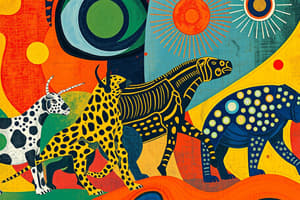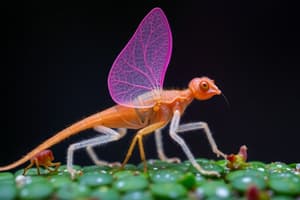Podcast
Questions and Answers
What is the main advantage of asexual reproduction?
What is the main advantage of asexual reproduction?
- Increased genetic variation
- Production of healthier offspring
- Requirement of a partner
- Faster reproduction rate (correct)
What is the result of meiosis?
What is the result of meiosis?
- Production of gametes with half the number of chromosomes (correct)
- Production of identical daughter cells
- Production of somatic cells
- Production of gametes with same number of chromosomes
What is a heritable trait?
What is a heritable trait?
- A trait that is dominant
- A trait acquired during an individual's life
- A trait passed on from parents through sexual reproduction (correct)
- A trait that results from a mutation
What is the function of the nucleus in a cell?
What is the function of the nucleus in a cell?
What is a nucleotide?
What is a nucleotide?
What is the result of mutation?
What is the result of mutation?
What is the purpose of mitosis?
What is the purpose of mitosis?
What is a disadvantage of asexual reproduction?
What is a disadvantage of asexual reproduction?
What is the primary characteristic that defines a species?
What is the primary characteristic that defines a species?
What is the term for the formation of new and distinct species through evolution?
What is the term for the formation of new and distinct species through evolution?
What is the term for an organism that can tolerate a wide range of environmental conditions and eat a variety of foods?
What is the term for an organism that can tolerate a wide range of environmental conditions and eat a variety of foods?
What is the process by which favourable traits become more common in successive generations and unfavorable traits become less common?
What is the process by which favourable traits become more common in successive generations and unfavorable traits become less common?
What is the term for a characteristic that helps an organism survive in its environment?
What is the term for a characteristic that helps an organism survive in its environment?
Why does sexual reproduction promote biodiversity?
Why does sexual reproduction promote biodiversity?
Flashcards are hidden until you start studying
Study Notes
Biological Diversity
- A species is a group of organisms with similar characteristics that can interbreed and produce fertile offspring.
- Intraspecies variation refers to the differences within a species, such as different hair colors in humans.
- Interspecies variation refers to the differences between species, such as dogs having four legs and chickens having two legs.
Adaptations
- An adaptation is a characteristic that helps an organism survive in its environment.
- Structural adaptations include physical features such as wings, webbed feet, and elephant tusks.
- Behavioural adaptations include hibernation, migration, and nocturnal behaviour.
Speciation and Evolution
- Speciation is the formation of new and distinct species through evolution.
- Competition between species can lead to speciation.
- Charles Darwin's theory of natural selection states that favourable traits become more common in successive generations, while unfavourable traits become less common.
- Common ancestors can give rise to new species through speciation.
Niche
- A broad niche refers to an organism's ability to tolerate a variety of environmental conditions and eat a wide range of foods, such as raccoons.
- A narrow niche refers to an organism's limited tolerance for specific environmental conditions and diet, such as pandas.
Reproduction
- Sexual reproduction promotes biodiversity by producing genetically unique offspring, increasing variation within a population.
- Asexual reproduction lacks genetic variation, making offspring more vulnerable to disease.
- Types of asexual reproduction include binary fission, asexual spores, budding, and vegetative reproduction.
Inheritance
- Heritable traits are passed on from parents through sexual reproduction, such as eye colour.
- Non-heritable traits are acquired by the individual during their lifetime, such as a tattoo.
- Continuous variation results in a wide range of possible phenotypes, such as eye colour.
- Discrete variation results in only a few possible phenotypes, such as blood type or earlobe shape.
DNA and Chromosomes
- A base is one of the building blocks of DNA, including cytosine, guanine, adenine, and thymine.
- A nucleotide includes one nitrogen base, one sugar, and one phosphate.
- A chromosome is a section of DNA containing several genes.
- DNA includes all the chromosomes, which are stored in the nucleus of a cell.
- A cell is the smallest unit of life, containing all the genetic information.
Mutations and Cell Division
- A mutation is a change or variation in the structure of a gene.
- A mutagen is a substance or form of energy that causes a mutation.
- Mitosis is a type of cell division used for growth and repair.
- Meiosis is a type of cell division that results in the production of sperm and egg cells.
Studying That Suits You
Use AI to generate personalized quizzes and flashcards to suit your learning preferences.



